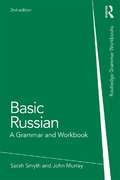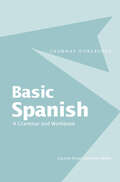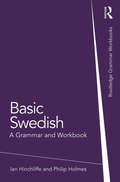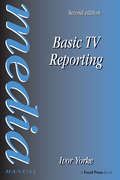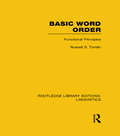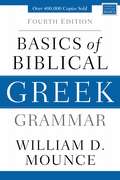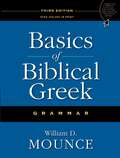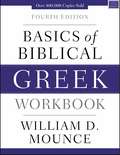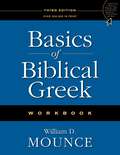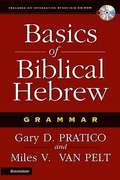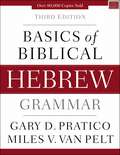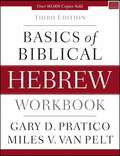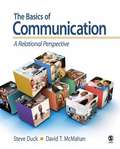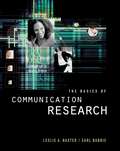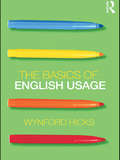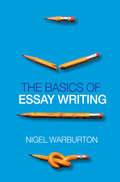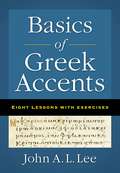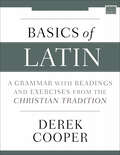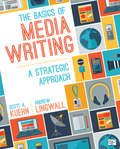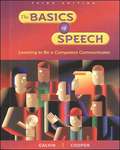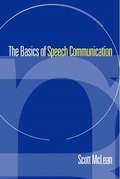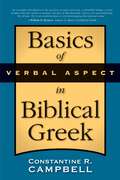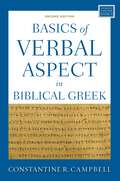- Table View
- List View
Basic Russian: A Grammar and Workbook (Grammar Workbooks Ser.)
by John Murray Sarah SmythDesigned for students with a basic knowledge of Russian, this book provides an accessible reference grammar and related exercises in a single volume.Across more than forty grammar topics it introduces the student to Russian people and culture through the medium of the language used today, covering the core material which the student would expect to encounter in their first year of learning Russian.Complete with a full key to exercises and glossary, Basic Russian is a user-friendly reference grammar suitable for both independent study and class use.
Basic Spanish: A Grammar and Workbook (Grammar Workbooks)
by Irene Wilkie Carmen ArnaizPresenting twenty individual grammar points in lively and realistic contexts, Basic Spanish is an accessible reference grammar with related exercises in one, easy to follow volume. Beginning with the simpler aspects of Spanish and progressing on to more complex areas, each chapter contains grammar points that are followed by examples and exercises selected to reinforce the topic. A first-class introduction to the language, features of this practical book include: * authentic reading texts to encourage an understanding of Spain and Spanish-speaking countries * reference to Latin American usage where appropriate * abundant exercises with full answer key * glossary of grammatical terms. Clearly presented and user-friendly, Basic Spanish provides readers with the basic tools to express themselves in a wide variety of situations, making it an ideal reference and practice resource for both beginners and students with some knowledge of the language.
Basic Swedish: A Grammar and Workbook (Grammar Workbooks)
by Ian Hinchliffe Philip HolmesBasic Swedish: A Grammar and Workbook combines an accessible basic reference grammar and related exercises in one volume, and covers most of the topics that students might expect to deal with in their first year of learning Swedish. Each of the 25 units discusses one or more grammar topics, with examples that are subsequently practised in the exercises that follow. The book introduces the contemporary language against a backdrop of Swedish culture, society, geography, customs and history. Each unit ends with a cultural text that outlines an aspect of Swedish culture and exemplifies and consolidates the grammar topic examined in the unit. Features include: clear grammatical explanations with examples in Swedish and English vocabulary based on a major corpus of written Swedish in order to guarantee authenticity and relevance cross-references to other units over 100 exercises with a key to all the correct answers full vocabulary list at the end of the book. The book is suitable both for independent study and for class use. It can be used by absolute beginners and those who have advanced a little further.
Basic TV Reporting: Media Manuals (Media Manual Ser.)
by Ivor YorkeBasic TV Reporting is a practical, easy to read guide to the skills needed to become a successful television reporter - arguably the most demanding and glamorous job in journalism. The book describes the role in detail, how reporters fit into the editorial team and where their duties begin and end. Basic TV Reporting is a practical, easy to read guide to the skills needed to become a successful television reporter - arguably the most demanding and glamorous job in journalism. The book describes the role in detail, how reporters fit into the editorial team and where their duties begin and end.The late Ivor Yorke has enjoyed a wealth of experience to pass on to aspiring broadcast journalists, having spent more than 20 years as a writer, reporter, producer and editor, before becoming Head of Journalist Training, BBC News and Current Affairs. He was also a freelance training consultant. He is the author of Television News (now in its third edition) and co-author with the late Bernard Hesketh of An Introduction to ENG, also published by Focal Press.Reviews: `This is a short, well-constructed book which is of as much value to the interviewed as to the interviewer. It is practical and down-to-earth (`keep off the gin, and stick to the tonic') and delightfully easy to read.' British Journal of Educational Technology.' Easy to read guide to the skills needed to become a successful TV reporter.'Voice of the Listener
Basic Word Order: Functional Principles (Routledge Library Editions: Linguistics)
by Russell S TomlinThis book examines the frequencies of the six possible basic word (or constituent) orders (SOV, SVO, VSO, VOS, OSV, OVS) provides a typologically grounded explanation for those frequencies in terms of three independent, functional principles of linguistic organization. From a database of nearly 1,000 languages and their basic constituent orders, a sample of 400 languages was produced that is statistically representative of both the genetic and areal distributions of the world’s languages. This sample reveals the following relative frequencies (in order from high to low) of basic constituent order types: (1) SOV and SVO, (2) VSO, (3) VOS and OVS, (4) OSV. It is argued that these relative frequencies can be explained to be the result of the possible interactions of three fundamental functional principles of linguistic organization. Principle 1, the thematic information principle, specifies that initial position is the cross-linguistically favoured position for clause-level thematic information. Principle 2, the verb-object bonding principle, describes the cross-linguistic tendency for a transitive verb and its object to form a more tightly integrated unit, syntactically and semantically, than does a transitive verb and its subject. Principle 3, the animated principle, describes the cross-linguistic tendency for semantic arguments which are either more animate or more agentive to occur earlier in the clause. Each principle is motivated independently of the others, drawing on cross-linguistic data from more than 80 genetically and typologically diverse languages. Given these three independently motivated functional principles, it is argued that the relative frequency of basic constituent order types is due to the tendency for the three principles to be maximally realized in the world’s languages. SOV and SVO languages are typologically most frequent because such basic orders reflect all three principles. The remaining orders occur less frequently because they reflect fewer of the principles. The 1,000-language database and the genetic and areal classification frames are published as appendices to the volume.
Basics of Biblical Greek Grammar: Fourth Edition
by William D. MounceClear. Understandable. Carefully organized. Basics of Biblical Greek Grammar by William D. Mounce is the standard textbook for colleges and seminaries. Since its initial publication in 1993 its integrated approach has helped more than 250,000 students learn New Testament Greek.The fourth edition of Basics of Biblical Greek Grammar has been updated throughout based on continuing feedback from professors, students, self-learners, and homeschoolers, making it even more effective for today’s students. As well, improvements have been made based on recent developments in scholarship.The key to the effectiveness of Basics of Biblical Greek Grammar in helping students learn is in how it introduces them to the language. Students learn about the features of the Greek language in a logical order, with each lesson building upon the one before it. Unnecessary obstacles that discourage students and hinder progress are removed, such as rote memorization of endless verbal paradigms. Instead students receive encouragement along the way to assure them they are making the necessary progress. As well, detailed discussions are included at key junctures to help students grasp important concepts.By the time students have worked their way through Basics of Biblical Greek Grammar they will have learned:The Greek AlphabetVocabulary for words occurring 50 times or more in the Greek New TestamentThe Greek noun systemThe Greek verbal system, including indicative and nonindicative verbs, and participlesA robust suite of learning aids is available for purchase to be used alongside the textbook to help students excel in their studies. These include a workbook, video lectures for each chapter featuring the author, flashcards keyed to vocabulary in each chapter, a laminated quick study sheet with key concepts, and audio of the vocabulary for each chapter to aid in acquisition.
Basics of Biblical Greek Grammar: Fourth Edition (Zondervan Language Basics Series)
by William D. MounceClear. Understandable. Carefully organized. Basics of Biblical Greek Grammar by William D. Mounce is the standard textbook for colleges and seminaries. Since its initial publication in 1993 its integrated approach has helped more than 250,000 students learn New Testament Greek.The fourth edition of Basics of Biblical Greek Grammar has been updated throughout based on continuing feedback from professors, students, self-learners, and homeschoolers, making it even more effective for today’s students. As well, improvements have been made based on recent developments in scholarship.The key to the effectiveness of Basics of Biblical Greek Grammar in helping students learn is in how it introduces them to the language. Students learn about the features of the Greek language in a logical order, with each lesson building upon the one before it. Unnecessary obstacles that discourage students and hinder progress are removed, such as rote memorization of endless verbal paradigms. Instead students receive encouragement along the way to assure them they are making the necessary progress. As well, detailed discussions are included at key junctures to help students grasp important concepts.By the time students have worked their way through Basics of Biblical Greek Grammar they will have learned:The Greek AlphabetVocabulary for words occurring 50 times or more in the Greek New TestamentThe Greek noun systemThe Greek verbal system, including indicative and nonindicative verbs, and participlesA robust suite of learning aids is available for purchase to be used alongside the textbook to help students excel in their studies. These include a workbook, video lectures for each chapter featuring the author, flashcards keyed to vocabulary in each chapter, a laminated quick study sheet with key concepts, and audio of the vocabulary for each chapter to aid in acquisition.
Basics of Biblical Greek Grammar
by William D. MounceFirst published in 1993, Basics of Biblical Greek is the most popular introduction to the field, used in universities and seminaries around the world. Over 200,000 students have learned biblical Greek under its guidance. This significant third edition has been carefully developed in consultation with instructors, students, self-learners, and homeschoolers. Users can now take advantage to the many improvements made at the book’s website, www.Teknia.com, where they will find—for free—an online course, walking students through every chapter; vocabulary flashcards; video and audio helps; Greek fonts; quizzes for each chapter; fun songs and games; and much, much more. Now in a larger size, with an attractive 2-color design, the third edition adds an element of fun, with encouragement, songs, and more, which appear in the margins. Chapter 35 has been split into two chapters, “half-time review” sections have been added to every chapter, and new exegesis sections are now included. These and other improvements serve to enhance the learning experience and will continue BBG’s legacy as the premier introduction to biblical Greek.
Basics of Biblical Greek Workbook
by William D. MounceThis expanded and updated workbook is designed with the student in mind and intended for use with the standard-setting Basics of Biblical Greek Grammar textbook, now in its fourth edition.Two optional chapters have been added to the Basics of Biblical Greek Workbook, allowing students to read large chunks of the biblical text and enjoy the fruits of their labor faster than ever before. Each chapter is divided into six sections and includes extensive exercises and significant biblical passages for translation.One of the most helpful and unique features of the workbook remains. You can go through the workbook on one of two tracks: Track One follows the workbook (and textbook) in its regular order, while Track Two is organized so you can learn verbs earlier in the course.
Basics of Biblical Greek Workbook
by William D. MounceExpanded, student-friendly workbook for use with Basics of Biblical Greek textbook This expanded workbook is designed with you, the student, in mind and intended for use with the standard-setting Basics of Biblical Greek textbook, now in its third edition. Two optional chapters have been added to the Basics of Biblical Greek Workbook, allowing you to read large chunks of the biblical text and enjoy the fruits of your labor faster than ever before. Each chapter is divided into six sections and includes extensive exercises and significant biblical passages for translation. One of the most helpful and unique features of the workbook remains. You can go through the workbook on one of two tracks: Track 1 follows the workbook (and textbook) in its regular order, while Track 2 is organized so you can learn verbs earlier in the course. You will also benefit from the many resources at www.Teknia.com. Not only is the flexible two-track system even easier to use online, but a workbook answer key is also provided. Many other resources are available, including vocabulary flashcards; video and audio helps; Greek fonts; quizzes for each chapter; fun songs and games; and much, much more. Now available (show covers for: laminated study sheet, vocabulary cards)
Basics of Biblical Hebrew Grammar
by Gary D. Pratico Miles V. Van PeltFeatures of Basics of Biblical Hebrew Grammar, Second Edition text: * Combines the best of inductive and deductive approaches * Uses actual examples from the Hebrew Old Testament rather than 'made-up' illustrations * Emphasizes the structural pattern of the Hebrew language rather than rote memorization, resulting in a simple, enjoyable, and effective learning process * Colored text highlights particles added to nouns and verbs, allowing easy recognition of new forms * Chapters Two (Hebrew Vowels), Nine (Pronominal Suffixes), Seventeen (Waw Consecutive), Eighteen (Imperative, Cohortative, and Jussive), and Twenty-Three (Issues of Sentence Syntax) are revised and expanded * Section of appendices and study aids is clearly marked for fast reference * Larger font and text size make reading easier * Updated author website with additional Hebrew language resources and product information (www.basicsofbiblicalhebrew.com) Features of updated CD-ROM: * Full answer key to the accompanying workbook (compatible with Windows and Macintosh) * Scripture indexes to both the grammar and the workbook. <P> <i>Advisory: Bookshare has learned that this book offers only partial accessibility. We have kept it in the collection because it is useful for some of our members. To explore further access options with us, please contact us through the Book Quality link on the right sidebar. Benetech is actively working on projects to improve accessibility issues such as these. </i>
Basics of Biblical Hebrew Grammar: Third Edition (Zondervan Language Basics Series)
by Gary D. Pratico Miles V. Van PeltClear. Understandable. Carefully organized. Basics of Biblical Hebrew Grammar by Gary D. Pratico and Miles V. Van Pelt is the standard textbook for colleges and seminaries. Since its initial publication in 2001 its integrated approach has helped more than 80,000 students learn Biblical Hebrew.The third edition of Basics of Biblical Hebrew Grammar represents a significant updating and revision of the previous edition with the goal of providing students with the best possible tool for learning Biblical Hebrew. Some of the keys to the effectiveness of Basics of Biblical Hebrew Grammar in helping students learn is that it:Combines the best of inductive and deductive approachesUses actual examples from the Hebrew Old Testament rather than &“made-up&” illustrationsEmphasizes the structural pattern of the Hebrew language rather than rote memorization, resulting in a simple, enjoyable, and effective learning processEmploys colored text that highlights key features of nouns and verbs, allowing easy recognition of new formsIncludes appendices of verbal paradigms and diagnostics for fast reference and a complete vocabulary glossaryDisplays larger font and text size, making reading easierBy the time students have worked their way through Basics of Biblical Hebrew Grammar they will have learned:The Hebrew AlphabetVocabulary for words occurring 70 times or more in the Hebrew BibleThe Hebrew noun systemThe Hebrew verbal systemA robust suite of learning aids is available for purchase to be used alongside the textbook to help students excel in their studies. These include a workbook; video lectures for each chapter featuring the author; flashcards keyed to vocabulary in each chapter; a laminated study sheet with key concepts; audio of the vocabulary for each chapter to aid in acquisition; and a compact guide to help refresh students refresh their memory on language forms, grammar, and word meanings.
Basics of Biblical Hebrew Workbook: Third Edition (Zondervan Language Basics Series)
by Gary D. Pratico Miles V. Van PeltThis updated workbook is designed with the student in mind and intended for use with the standard-setting Basics of Biblical Hebrew Grammar textbook, now in its third edition. In addition to corresponding to the revisions and updates in Basics of Biblical Hebrew Grammar, this workbook includes significant changes to the interior presentation; less unnecessary questions and exercises; and six reading texts interspersed among the exercises for the derived stems.The workbook is an essential chapter-by-chapter companion and includes helpful exercises and translation homework. As students complete the assignments in the workbook, the concepts they have been learning from the main grammar are reinforced, making this an invaluable study tool to enhance student learning.
The Basics of Communication: A Relational Perspective
by Steve Duck David T. McmahanThis introductory communication textbook explores fundamental communication concepts, theories, skills, and contexts with a thematic integration to everyday life that allows all of these things to cohere and offers an engaging look at the inseparable connection between relationships and communication, highlighting the roles that interpersonal connections play in casual discussions as well as in public speaking.
The Basics of Communication Research
by Leslie A. Baxter; Earl BabbieCombining the time tested classical work of Earl Babbie with the insights of one of the most recognized and respected names in speech communication research, THE BASICS OF COMMUNICATION RESEARCH is the book for the Communication research methods course. With the authors' collective experience teaching research methods and as active researchers themselves you will find this text to be the authoritative text for your course. The authors frame research as a way of knowing, and provide balanced treatment to both quantitative and qualitative research traditions in communication research and present it in a student friendly and engaging format. It provides in-depth treatment of the role of reasoning in the research enterprise and how this reasoning process plays itself out in planning and writing a research proposal and report.
The Basics of English Usage
by Wynford HicksShould I say "He is taller than I" or "He is taller than me?" Do you spell it "blond" or "blonde"? If you’ve ever been stopped in your tracks by questions like these, then this book is for you. A complete pocket guide to the ins and outs of everyday English, The Basics of English Usage will tell you all you need to know about such topics as: correct spelling good grammar and style punctuation and how to use it problem words that everyone gets wrong. Including guides to further reading and online resources, The Basics of English Usage is an indispensable survival guide for anyone wanting to improve their writing and communication.
The Basics of Essay Writing
by Nigel WarburtonNigel Warburton, bestselling author and experienced lecturer, provides all the guidance and advice you need to dramatically improve your essay-writing skills. The book opens with a discussion of why it is so important to write a good essay, and proceeds through a step-by-step exploration of exactly what you should consider to improve your essays and marks.You will find help on how to:focus on answering the question askedresearch and plan your essaybuild and sustain an argumentimprove your writing style and tone.The Basics of Essay Writing is packed full of good advice and practical exercises. Students of all ages and in every subject area will find it an easy-to-use and indispensable aid to their studies.
Basics of Greek Accents: Eight Lessons with Exercises
by John A. LeeBasics of Greek Accents by John A. L. Lee is a compact, student-friendly, and practical guide to accents for students of both classical and biblical Greek. In eight simple lessons students will learn the basics of ancient Greek accentuation.Ideal for beginners who are just learning the language or for intermediate students who have learned some Greek but are unsure of their accents this handy resource avoids theory and concentrates on taking the learner through the essentials in a natural sequence and reinforces learning by means of simple exercises.
Basics of Latin: A Grammar with Readings and Exercises from the Christian Tradition
by Derek CooperBasics of Latin: A Grammar with Readings and Exercises from the Christian Tradition by Derek Cooper introduces students, independent learners, and homeschoolers to the basics of Latin grammar with all readings and exercises taken from texts in the Christian tradition.As part of the widely-used Zondervan Language Basics series of resources, Cooper's Latin grammar is a student-friendly introduction. It helps students learn by:Minimizing technical jargonProviding only the information needed to learn the basicsBreaking the grammar of language down into manageable and intuitive chunksIllustrating the grammar in question by its use in rich selections from ancient Christian authors.Providing grammar, readings, exercises, and a lexicon all in one convenient volume.Basics of Latin provides an ideal first step into this important language and focuses on getting the student into texts and translation as quickly as possible.
The Basics of Media Writing: A Strategic Approach
by Scott A. Kuehn James Andrew LingwallThe Basics of Media Writing: A Strategic Approach helps readers develop the essential writing skills and professional habits needed to succeed in 21st-century media careers. This research-driven, strategy-based media writing textbook digs deeply into how media professionals think and write in journalism, public relations, advertising, and other forms of strategic communication. Authors Scott A. Kuehn and Andrew Lingwall have created two comprehensive writing models to help students overcome their problems in finding and developing story topics by giving them “starting points” to begin writing. The Professional Strategy Triangle model shows students how to think critically about the audience, the situation, and the message before starting a news story or persuasive piece and the FAJA four-point model asks students a series of questions about their story type (Fact, Analysis, Judgment, or Action) to guide them to the right angle or organizational structure for their message. Rooted in classical rhetorical methods, this step-by-step technique enables readers to strategically approach each writing task, no matter the format.
The Basics of Media Writing: A Strategic Approach
by Scott A. Kuehn James Andrew LingwallThe Basics of Media Writing: A Strategic Approach helps readers develop the essential writing skills and professional habits needed to succeed in 21st-century media careers. This research-driven, strategy-based media writing textbook digs deeply into how media professionals think and write in journalism, public relations, advertising, and other forms of strategic communication. Authors Scott A. Kuehn and Andrew Lingwall have created two comprehensive writing models to help students overcome their problems in finding and developing story topics by giving them “starting points” to begin writing. The Professional Strategy Triangle model shows students how to think critically about the audience, the situation, and the message before starting a news story or persuasive piece and the FAJA four-point model asks students a series of questions about their story type (Fact, Analysis, Judgment, or Action) to guide them to the right angle or organizational structure for their message. Rooted in classical rhetorical methods, this step-by-step technique enables readers to strategically approach each writing task, no matter the format.
The Basics of Speech: Learning to Be a Competent Communicator (3rd Edition)
by Kathleen M. Galvin Pamela J. CooperThe Basics of Speech addresses a very important skill--communication. This introductory text addresses interpersonal and group communication, public speaking, debate, parliamentary procedure, and oral interpretation. Based on the concept that oral communication is a skill learned by doing, students are involved in thinking and expressing themselves from the first to the last chapter.
The Basics of Speech Communication
by Scott McleanAn introduction to terms, concepts and theory of speech communication.
Basics of Verbal Aspect in Biblical Greek
by Constantine R. CampbellVerbal aspect in the Greek language has been a topic of significant debate in recent scholarship. The majority of scholars now believe that an understanding of verbal aspect is even more important than verb tense (past, present, etc.). Until now, however, there have been no accessible textbooks, both in terms of level and price (most titles on the topic retail for more than $100). In this book, Constantine Campbell investigates the function of verbal aspect within the New Testament Greek narrative. He has done a marvelous job in this book of simplifying the concept without getting caught up using terms of linguistics that no one except those schooled in that field can understand. The book includes exercises, an answer key, glossary of key concepts, an appendix covering space and time, and an index to Scripture cited. Professors and students, at both the undergraduate and graduate levels, will use this is as a supplemental text in both beginning and advanced Greek courses. Pastors that study the Greek text will also appreciate this resource as a supplement to their preaching and teaching.
Basics of Verbal Aspect in Biblical Greek: Second Edition (Zondervan Language Basics Series)
by Constantine R. CampbellVerbal aspect in the Greek language has been a topic of significant debate in recent scholarship. The majority of scholars now believe that an understanding of verbal aspect is even more important than verb tense (past, present, etc.). Yet there still are no alternative accessible textbooks, both in terms of level and price. In the second edition, Constantine R. Campbell investigates the function of verbal aspect within the New Testament Greek narrative in light of the last fifteen years of the latest scholarship.In Basics of Verbal Aspect in Biblical Greek, Second Edition, Campbell has done a marvelous job in this book of simplifying the concept without getting caught up using terms of linguistics that only experts can understand. The book includes expanded and updated discussion, revised exercises, an answer key, a glossary of key concepts, an appendix covering space and time, and an index of Scriptures cited. Professors and students, at both the undergraduate and graduate levels, will use this is as a supplemental text in both beginning and advanced Greek courses. Pastors that study the Greek text will also appreciate this resource as a supplement to their preaching and teaching.
